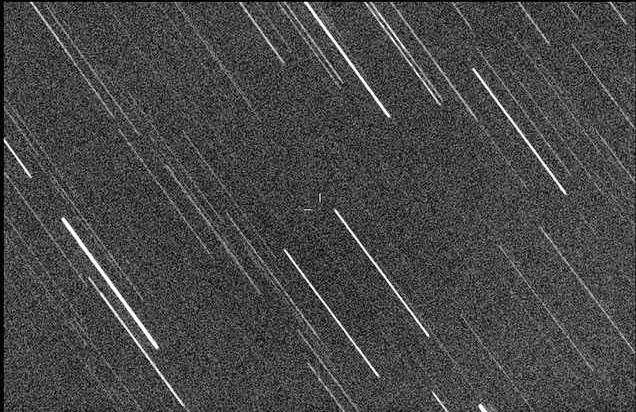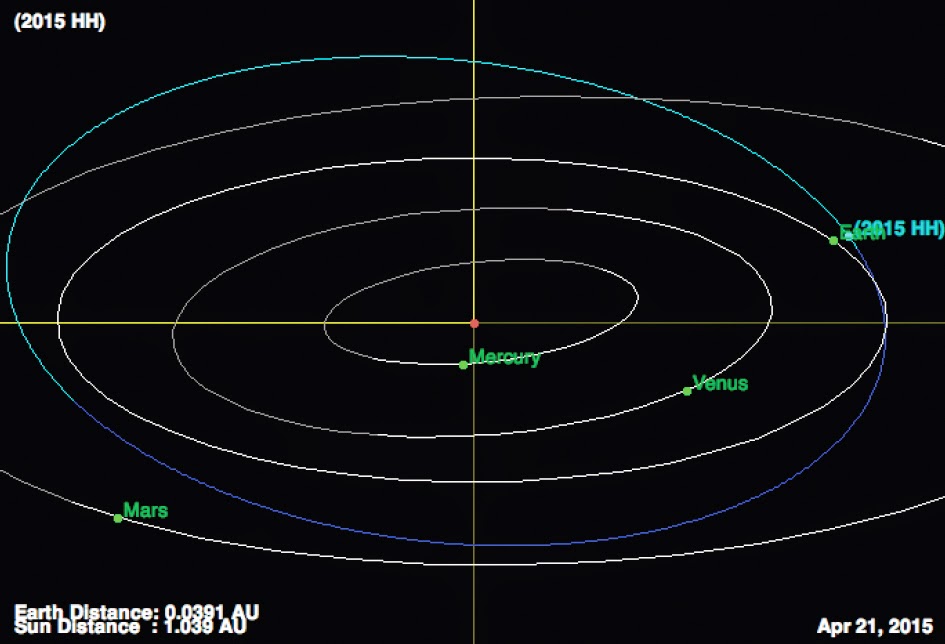Asteroid
2015 HC1 passed by the Earth at a distance of 8 407 100 km (21.9 times
the average distance between the Earth and the Moon, or 5.62% of the
average distance between the Earth and the Sun), slightly after 10.15 pm
GMT on Wednesday 29 April 2015. There was no danger of the asteroid
hitting us, though had it done so it would have presented only a minor
threat. 2015 HC1 has an estimated equivalent diameter of 6-21 m (i.e.
it is estimated that a spherical object with the same volume would be 6-21 m in diameter), and an object of this size would be expected to
explode in an airburst (an explosion caused by superheating from
friction with the Earth's atmosphere, which is greater than that caused
by simply falling, due to the orbital momentum of the asteroid) in the
atmosphere between 38 and 21 km above the ground, with only fragmentary
material reaching the Earth's surface.
The calculated orbit of 2015 HC1. JPL Small Body Database.
2015 HT10 was discovered on 17 April 2015 (twelve days before its closest approach to the Earth) by the Dark Energy Camera on the Blanco 4-meter Telescope
at the Cerro Tololo Inter-American Observatory in La Serena, Chile.
The
designation 2015 HC1 implies that it was the 28th asteroid (asteroid C1) discovered in the secondt half of April 2015 (period 2015 H).
While
2015 HC1 occasionally comes near to the Earth, it does not actually
cross our orbital path. It has an elliptical 576 day orbit, at an angle
of 1.97° to the plane of the Solar System, that takes it from 1.06 AU
from the Sun (1.06 times the average distance at which the Earth orbits
the Sun), slightly outside our orbit, to 1.64 AU from the Sun, (1.64
times the distance at which the Earth orbits the Sun and more
than the average distance at which the planet Mars orbits the Sun). As a
Near Earth Object that remains strictly outside the orbit of the Earth
it is classed as an Amor Family Asteroid. This
means that close encounters between 2015 HC1 and the Earth are quite
common, with
the next predicted for June 2067. The asteroid is thought to also have occasional close encounters with Mars, the last of which would have occured in August 2011.
See also...
Asteroid
2015 HT10 passed by the Earth at a distance of 627 100 km (1.63 times
the average distance between the Earth and the Moon, or 0.42% of the
average distance between the Earth and the Sun), at about 4.55 am
GMT on Wednesday 29 April...
 Asteroid 2015 HQ11 passes the Earth. Asteroid
2015 HQ11 passed by the Earth at a distance of 490 100 km (1.27 times
the average distance between the Earth and the Moon, or 0.33% of the
average distance between the Earth and the Sun), slightly before 6.20 am
GMT on Saturday 25 April...
Asteroid 2015 HQ11 passes the Earth. Asteroid
2015 HQ11 passed by the Earth at a distance of 490 100 km (1.27 times
the average distance between the Earth and the Moon, or 0.33% of the
average distance between the Earth and the Sun), slightly before 6.20 am
GMT on Saturday 25 April...
Asteroid
2015 HH passed by the Earth at a distance of 4 513 000 km (11.7 times
the average distance between the Earth and the Moon, or 3.02% of the
average distance between the Earth and the Sun), slightly after 10.25 am
GMT on Tuesday 14 April 2015. There was...
Follow Sciency Thoughts on Facebook.



